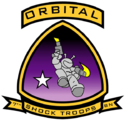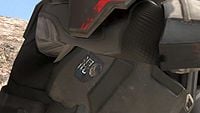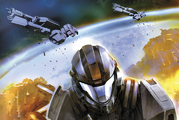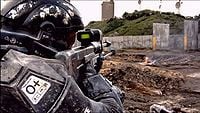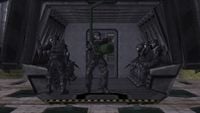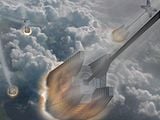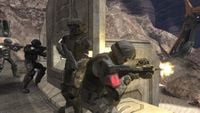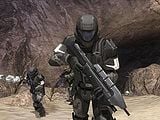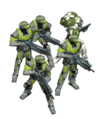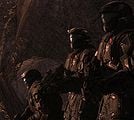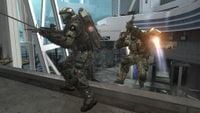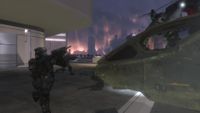Orbital Drop Shock Troopers: Difference between revisions
From Halopedia, the Halo wiki
m (Spartacus moved page Orbital Drop Shock Trooper to Orbital Drop Shock Troopers: Per talk page discussion.) |
|||
| Line 238: | Line 238: | ||
*''[[Halo: Ghosts of Onyx]]'' {{Mo}} | *''[[Halo: Ghosts of Onyx]]'' {{Mo}} | ||
*''[[Halo: The Cole Protocol]]'' | *''[[Halo: The Cole Protocol]]'' | ||
*''[[Halo: Glasslands]]'' | |||
*''[[Halo: The Thursday War]]'' | |||
{{Col-2}} | {{Col-2}} | ||
*''[[Halo: Evolutions - Essential Tales of the Halo Universe]]'' | *''[[Halo: Evolutions - Essential Tales of the Halo Universe]]'' | ||
Revision as of 13:57, October 2, 2012
| Orbital Drop Shock Troopers | |
|---|---|
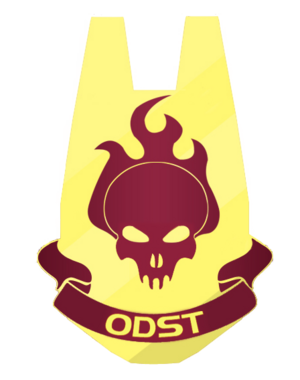
| |
|
Type: |
|
|
Affiliation: |
|
|
Operational authority: |
|
|
Branch: |
|
|
Size: |
Several divisions |
|
Notable commanders: |
|
- Major Silva: "Most of the crew - not to mention your fellow jarheads - will be leaving the ship in lifeboats. They'll ride to the surface in air conditioned comfort, sipping wine, and nibbling on appetizers. Not you, however. Oh no, you're going to leave the Pillar of Autumn in a different method. Tell me boys and girls... how will you leave?"
- Shock Troopers: "We go feet first, sir!"
- — Major Antonio Silva rousing his squad aboard the Pillar of Autumn
The Orbital Drop Shock Troopers (ODST)[note 1] are a special operations capable unit of the UNSC Marine Corps. The ODST are one of the primary special operations forces of the United Nations Space Command, and are under the administrative and operational control of Naval Special Weapons.[1][2]
Background
Under the authority of Naval Special Weapons, the ODSTs' methods of operation allow them to conduct missions against targets that more conventional forces cannot approach undetected. ODSTs are recruited from the various special operations units in the Marine Corps and is a strictly all volunteer fighting force. Potential ODSTs are selected because of their performance in their chosen Military Occupational Specialty; every ODST candidate is a veteran from another special operations outfit and therefore have already gone through at least two layers of screening and months of intense training — not counting the years of training received before volunteering for the ODST. There are no age or gender restrictions — as long as the candidate meets the physical and mental requirements they are guaranteed the opportunity to try out for the ODST. Once in the ODST, a candidate's training continues - its entrance requirements serve as a third layer of screening upon two more, where applicants would have theoretically failed to pass. Candidates would, therefore, already have extensive experience in conducting the types of high-risk missions that the Orbital Drop Shock Troopers typically perform.[2]
ODST units are not embedded within conventional UNSC forces, they do however participate in joint operations, and tend to be force multipliers - increasing the effectiveness, willingness, and morale of those they fight alongside. ODST combat teams usually consist of six to eight - with each combat team specializing in a particular mission set, but they are expected to be flexible enough to adapt to any given situation. These combat teams however can vary from company to company. ODSTs are known for their unusual methods of insertion, dropping from orbit onto terrestrial environments. Similar to their infantry counterparts, the ODSTs maintain units of varying strength aboard many UNSC vessels and installations.[2]
The ODST perform highly specialized, small scale, high-risk operations including:[2][1]
- Deep ground surveillance and long range reconnaissance: Patrols in small groups, in uniform, usually far behind the enemy lines. While direct ground surveillance units may direct air or artillery strikes against enemy positions, they strive to be unobserved, and have only self-defense, not direct action, capability. Groups engaging in surveillance deep behind enemy lines, are commonly known as Long Range Reconnaissance Patrols.
- Direct action: Short-duration strikes and other small-scale offensive actions conducted as a special operation in hostile, denied, or politically sensitive environments and which employ specialized military capabilities to seize, destroy, capture, exploit, recover, or damage designated targets. Direct action differs from conventional offensive actions in the level of physical and political risk, operational techniques, and the degree of discriminate and precise use of force to achieve specific objectives.
- Unconventional warfare: Military and paramilitary operations, normally of long duration, predominantly conducted by indigenous or surrogate forces who are organized, trained, equipped, supported, and directed in varying degrees by an external source. It includes guerrilla warfare and other direct offensive, low visibility, covert, or clandestine operations, as well as the indirect activities of subversion, sabotage, intelligence gathering, escape and evasion.
- Counter-terrorism operations: The response to terrorist threats and/or acts, both real and imputed.
- Counter-contraband operations: Missions undertaking the recapturing of smuggled/stolen goods.
- Personnel and special equipment recovery/capture: The recovery/medical treatment of friendly personnel in combat environments, as well as the capability of capturing high valued individuals and any equipment.
History
Origins
The idea of inserting highly trained troops behind enemy lines from high altitudes has its roots in the paratroopers of 20th and 21st century fame, who dropped frequently behind enemy lines to capture strategically important targets in anticipation for a larger advance by more conventional and numerous military forces.
Such troops were first used prior to World War II by Italian and Soviet forces, but the first serious application of the doctrine was seen in 1940 by the German Air Force in World War II to overrun the Allied positions in Denmark, the Netherlands and the legendary Eben-Emael fortress in Belgium. Paratroops were also used to capture the entire island of Crete. Later, during the Battle of Normandy known as Operation Overlord on June 6, 1944, when two American Airborne Divisions and one British Airborne Division landed behind enemy lines in Normandy, France on D-Day and again in Operation Market Garden. Although they were only marginally successful, they proved the concept of paratroops as useful and effective in large scale warfare.
Interplanetary War
While the concept of dropping human soldiers from orbit had been around since the early 21st century, the Orbital Drop Shock Troopers as a force were formed alongside the inception of the UNSC.[3] The historic first extraterrestrial deployment of UNSC Marines in the Martian Campaign against the Neo-Communist Koslovics in 2163 not only proved the feasibility of deploying soldiers from space, but also the effectiveness of such an option, shaping Marine doctrine for centuries to come.[4]
The conclusion of the Interplanetary War in 2170, along with the signing of the Callisto Treaty and the subsequent years that followed, the ODST saw little action as more political, and more important issues such as overpopulation and famine and a massive military with no purpose gripped the postwar nations of Earth.[4] The first major combat re-emergence of the ODSTs occurred in 2490 during the beginnings of the civil conflict between the UEG and the Insurrection. Using the members of the ORION Project as exemplary models,[5] the reputation of the ODST, as well as their training, was restored and enhanced as time passed. For the years leading up to 2525, the ODST conducted high-risk operations against the Insurrectionists, to either stop the enemy before they could carry out attacks against supporters, and officials of the Unified Earth Government or to cut off major suppliers to the Insurrectionists.
Human-Covenant War
- Main article: Human-Covenant War
On November 1, 2525, the UNSC moved into a full alert status after the devastating and horrifying first contact with the Covenant at Harvest; this marked a change in objectives for the ODST, who up until that point had been fighting the Insurrectionists. As humanity's military turned to meet the threat of the Covenant, divisions of ODSTs prepared to participate in the most critical engagements in the war and also to conduct the riskiest missions in the history of mankind. The Battle of Hat Yai marked one of the first deployments of ODSTs against Covenant ground forces; although the planet was lost in the ensuing conflict, the ODSTs were successfully extracted before the UNSC retreated.
Not long after the Harvest Campaign, the ODST participated in the Battle of Arcadia, where they assisted Marine forces and SPARTAN-II Red Team in defending the capital city from Covenant ground forces, thus allowing the evacuation of the civilian population. Having successfully kept Covenant forces from occupying the city, the Corps began launching multiple assaults on the Covenant's bases of operations to reclaim the planet. Several ODST platoons joined the Spirit of Fire's rescue operation after retaking the planet and soon participated in Battle of Shield 0459.
Following the enactment of the Cole Protocol in 2535, ODST combat teams were tasked with boarding commercial and private vessels and purging their navigation databases. During one of these routine operations, a group of ODSTs aboard the UNSC Midsummer Night were captured and taken to the Rubble. They, in conjunction with SPARTAN-II Gray Team, would later defeat a Kig-yar plan to trick the inhabitants of the Rubble out of their navigation data, which could compromise the location of Earth.
As the Human-Covenant war progressed, the ODST would participate in many engagements; among these were the Battle of Jericho VII, an assassination mission on Heian, the Battle of Skopje, the Battle of Sigma Octanus IV, the Battle of New Jerusalem, the Battle of Tribute, and the Battle of Ariel. The numerous campaigns and operations in which the ODST participated throughout the long war all pale in comparison to the Fall of Reach in 2552, during which countless ODSTs lost their lives defending strategic locations on the planet.
During the initial invasion of Reach, a large contingent of ODSTs participated in the Battle of Viery, assisting the UNSC Army in repelling the Covenant forces from the planet. Throughout the course of the battle, the UNSC formed joint forces to combat against the overwhelming Covenant forces. Some time during the event, several battalions were stationed on the UNSC Pillar of Autumn. As the planet fell to the Covenant onslaught, the vessel made a blind Slipspace jump away from the Epsilon Eridani system, discovering the long-abandoned Installation 04. During the Battle of Installation 04, shock troopers led by Major Antonio Silva and First Lieutenant Melissa McKay, operated as a guerrilla force by conducting hit-and-run operations against the forces of the Covenant's Fleet of Particular Justice.[6]
Fresh from the disastrous loss of Reach, the ODST participated in the most significant battle of the entire war: the Battle of Earth. The battle began on October 20, 2552, when a smaller-than-expected Covenant fleet led by the Prophet of Regret jumped into the Solar System. ODST combat teams, along with the Marines, began engaging Covenant forces on the Orbital Defense Platforms Cairo, Athens, and Malta. Despite the ODSTs' valiant efforts, Malta and Athens were destroyed. As the Covenant ship carrying the Prophet of Regret landed over the African mega-city of Mombasa, teams of ODSTs were deployed over the city from orbit in an attempt to board the carrier; before the teams could reach the target, however, the carrier jumped into Slipspace. Only a single squad managed to safely land in the city to carry out the retrieval of the Superintendent's data.
After Regret's unexpected retreat from New Mombasa, members of the 7th Shock Troops Battalion would later drop from the In Amber Clad onto Installation 05 during the operation to capture the Prophet of Regret. Most of these troopers would perish during the initial firefights against the Covenant, and only a few would escape back to Earth with Lieutenant Commander Miranda Keyes to lead a resistance against the Covenant occupation forces.[7]
Overall, the defense of Earth was one of the largest campaigns the ODST fought in during the entire war. The fighting spread across the globe and in space as the Fleet of Furious Redemption and the Prophet of Truth's own fleet attacked the remnants of the Orbital Defense Grid. The fleets soon deployed troops throughout the continents of North America, South America, Europe and Asia. The Battle of Cleveland is one example of the ODSTs' participation during the war on Earth. Two ODSTs from the 2nd Shock Troops Battalion fought alongside a detachment of Marines in the Battle of Pawas.[8] Troopers T. Rymann and S. Hartley were tasked with calculating the crash site of John-117 on Earth, while a Marine battalion was tasked with defending a narrow corridor between Covenant and UNSC forces in Pakistan. Bravo-21 and numerous Marines were killed in the clash, while Bravo-22 was injured along with some of the other surviving Marines. Their actions successfully allowed HIGHCOM to track and locate the Spartan.
After the opening of the Portal in November of 2552, the 11th Marine Force Reconnaissance/ODST, stationed aboard the UNSC Forward Unto Dawn, fought alongside SPARTAN John-117, during Operation: BLIND FAITH.[9] Men and women from this battalion were also some of the first humans to travel outside the Milky Way Galaxy, during the Battle of Installation 00.[10] One such assault happened during a mission to destroy numerous Covenant anti-aircraft artillery platforms overlooking a desert. These AA guns were destroyed by the ODSTs, allowing the UNSC Forward Unto Dawn to successfully land near the Cartographer building.[10] During the last battle of the Ark campaign - the last battle of the war - ODSTs were again airlifted into combat. This time, they punched holes in Covenant armor and artillery positions to allow SPARTAN-117 and the Arbiter to eliminate the Prophet of Truth. After the battle, the surviving ODSTs were taken back to Earth aboard the separatist ship Shadow of Intent. [11]
Organization
Personnel
The status of each trooper is in accordance with their last known appearance.
Equipment
Battle dress uniform
- Main article: ODST battle armor
The ODST battle dress uniform is the signature piece of equipment used by the ODSTs - the armor is vacuum-rated, capable of extravehicular activity for fifteen minutes. The ODST BDU has been in use for well over 50 years by the 105th, and remains untouched by its ability to protect its wearer during the toughest operations.Template:Fact
Human Entry Vehicle
- Main article: Single Occupant Exoatmospheric Insertion Vehicle
The Single Occupant Exoatmospheric Insertion Vehicle abbreviated SOEIV is a tear-drop shaped pod made of Titanium-A, lead foil and coated with ceramic skin. The SOEIV is the signature piece of equipment used by the ODSTs and is known for its risks and intense heat which has garnered 105th ODST Division the nickname "Helljumpers". While most combat deployments are made by means of ordinary dropships, the SOEIV was designed as a more efficient method of orbital deployment for high-risk operations.[12]
Trivia
- The ODST were heavily influenced by the Mobile Infantry from the novel Starship Troopers, which popularized the use of drop pods in science fiction.
- The Orbital Drop Shock Troopers have been referred to by Bungie as a futuristic successor to the American Marine Force Recon and the British Special Air Service.[13]
- On the right side of an ODST's body armor is a Chinese character which, when translated, means roughly "Complete Bad Ass", a reference to the ODSTs hardcore attitude. Putting these symbols together spells the Chinese word "混蛋", which stands for "bastard".
- In Halo: Uprising, when the ODSTs drop off the Hornets, they use a sort of cable they keep inside their belt, much like modern day armed forces off of a helicopter.
- The Orbital Drop Shock Troopers are a playable unit in Halo Wars. They are only available if the player chooses Captain Cutter as their hero unit.
- ODSTs, particularly the Rookie, are called "imps" by Covenant warriors, similarly to how SPARTANs are known as "demons" among their ranks.
- Captain Jacob Keyes had an ODST tattoo stenciled into his arm. He received this tattoo after he saved the lives of many ODSTs during a routine mission on the Finnegan's Wake.
Gallery
- ODST.png
The 7th Battalion insignia on an ODST's shoulder pauldron.
An ODST faces an enraged Jiralhanae.
ODSTs dropping into a Covenant prison camp in Cleveland.
Taylor H. Miles during the Battle of Ariel.
T. Rymann engages a Jiralhanae during the Battle of Sector Six.
- Mobassa ODST.jpg
An ODST fireteam in the streets of Mombasa.
Three ODSTs outside ONI Sword Base on Reach.
A team of Bullfrogs during the Raid on New Alexandria.
Two ODSTs get ready to board Gunnery Sergeant Buck's UH-144 Falcon in New Alexandria.
T. Rymann and S. Hartley at Sector Six in Pawa, Pakistan.
List of appearances
Notes
- ^ The plural form, when referring to the organization, is "ODST", as confirmed in the The Life, Halo: The Essential Visual Guide, ONI Candidate Assessment Program V5.02A, the ODST Field Guide, the audio commentary for The Babysitter, and several developer interviews. For example, it is proper to say, "Why did you join the ODST?", "The ODST are an elite force," or "We are ODST." However, when referencing individuals or groups of troopers, the plural is typically "ODSTs"; for instance, it is appropriate to refer to "a squad of ODSTs". However, one may also say, "a squad of ODST".
Sources
- ^ a b Halo: The Essential Visual Guide, page 131
- ^ a b c d Bungie.net, ODST Field Guide
- ^ Halo.bungie.org: Frank O'Connor/Robt McLees Interview - August 2008
- ^ a b Halo Encyclopedia, Chapter 2, page 42
- ^ Halo: Reach, Data pad 11
- ^ Halo: The Flood
- ^ Halo 2, The Great Journey
- ^ Halo: Combat Part Two
- ^ Halo Encyclopedia, Chapter 2, pages 56/57
- ^ a b Halo 3, campaign level The Ark
- ^ Halo 3, campaign level The Covenant
- ^ Halo: The Flood, page 35
- ^ Gameplayer: Halo 3: ODST Exclusive Developer Interview
